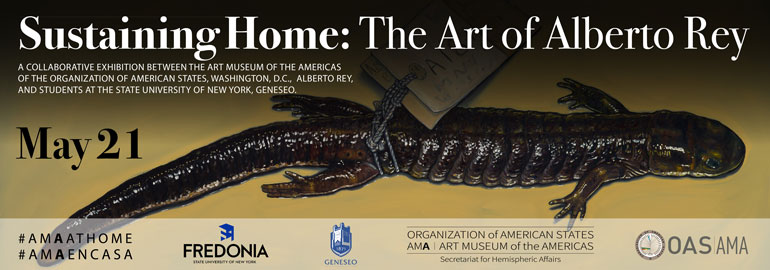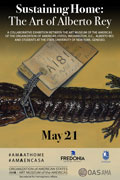
Wren Guzmán (they/them) is an Art History major, currently finishing up their second year at Geneseo. They say that working on this exhibition has motivated them more than ever to educate others on the importance of nature preservation and the beauty of the world we live in, and that it has been a rewarding experience.
On social media June 3, 2021
Rediscovering Lost Beauty: Icebergs Project
by Wren Guzman
The Lost Beauty: Icebergs Project by Alberto Rey is an intricate and beautiful way of encapsulating Rey’s experience visiting Iceland in 2003 and 2013. In the series, Rey paints the melting glaciers that he witnessed firsthand on these trips. The series is important because it brings together the catastrophe of climate change with Rey’s artistic expression in way that draws attention to the issues inherent to climate change in our world. As we focus more on the effects of climate change closer to home, we forget how these faraway glaciers are being affected and how their destiny is crucial for human survival. We have always taken them for granted but soon they could be completely gone and their possible destruction is chronicled in Rey’s Icebergs series.
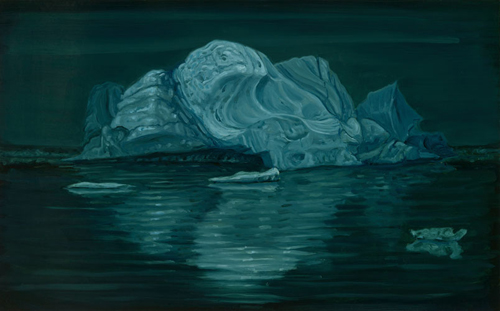
Lost Beauty: Icebergs IX, 2019-2021, Oils on Wooden Panel, 15 x 24"
In Alberto Rey’s Lost Beauty: Icebergs IX, I noticed that the palette in this work is mainly teal, accented with different shades of blue. The sky has three streaks, two green and a navy blue in the middle. These color choices echo what the world of icebergs once was before it became disturbed, when it was a place of color, composed of bright blues and greens. As Rey depicted it, the world of icebergs is an intimidating landscape to observe. At the center of the iceberg’s peak is a larger mound made up of several curved lines, shaded to create an illusion of deep divots. The delineating strokes on the central mound give a detailed shape to the mound and a texture that is bumpy and biomorphic. Taken collectively, these artistic choices make the central mound look like a haunting, distorted human skull with a gaping mouth and a brain-like surface at the top. There are also floating bits of ice coming toward the viewer that look like limbs. The piece uses contrast as a means of creating spatial depth to make the forms appear to be reaching toward the viewer. As Rey has described about what he saw during his trips to Iceland, “it was a shock to see the icebergs floating so close to the shoreline. There was also something sad about the 2,500-year-old icebergs slowly dying in front of us.” (Alberto Rey, “Lost Beauty Project, 2019-Present,” Art Projects, Alberto Rey, https://albertorey.com/site-specific-projects/) Overall, the human skull, as depicted by Rey, in this work, with its outstretched limbs signifies human death and how if we let matters get worse with the glaciers and climate change in general, it will ultimately lead to human extinction within the potential extinction of our beautiful, natural works.
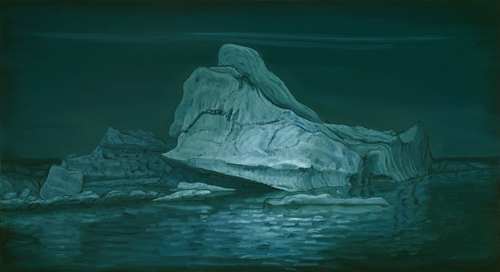
Lost Beauty: Icebergs XVI, 2019-2021, Oils on Wooden Panel, 19 x 36"
The palette Alberto Rey used for Lost Beauty: Icebergs XVI is composed of dim, cool tones, primarily teal and green, with the exception of white highlights. The palette is somber and looks like an apocalyptic landscape. The shift from green, which represents nature in our collective imaginary, is distorted through the use of teal. That distortion, in turn, mirrors the way human behavior is hurting nature. The work exhibits Rey’s thick brush strokes, which create the water and the reflection of the iceberg. The thick strokes are important because a close look at the reflection makes the iceberg appear to be fading away. Icebergs XVI predicts in visual form what will happen—what is already happening—as the icebergs melt away. In this painting, we can see bits and pieces of other glaciers broken off, with the thick brush strokes indicating the state of meltdown of the icebergs. The painted strokes appear to open crevices in the icebergs that look like cuts, personifying it as a living thing that is being hurt by our collective failure to act on climate change. As Rey describes in his discussion on his website, the icebergs, “Each seemed to possess their own identity and spirit.” Rey seems to be painting the icebergs passing away, a teal and green memorial in dedication to the glaciers.
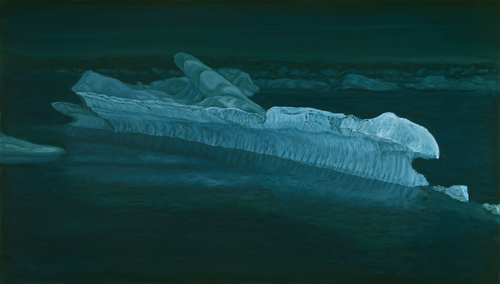
Lost Beauty: Icebergs XI, 2019-2021, Oils on Wooden panel, 44 x 25"
In comparison to other works, forming the Iceberg’s series, Alberto Rey’s, Lost Beauty: Icebergs XI is more linear. The shape of the subject resembles a parallelogram with cracks and curves embedded on its sides. Intersecting the composition at an angle is an oblong shape with shadows below and behind it creating the illusion of three-dimensionality. Rey’s glacier in this painting looks like a ship that is partially sunk into the water. When you focus on the upper left region of the subject, it paints its own, smaller picture. The scene looks as though it is painting its own demise. The subject is in a more open space and there’s a good emphasis on the shape of the glacier and the melting pattern as a kind of linear form. The way that Rey painted this glacier makes it look as if it is a mini landscape. Within that mini landscape, the strokes that give the piece a bumpy texture seem to carve out a walking path. Surrounding the area, we can see melting peaks, which mimic the real-time melting of the glaciers. According to a recent NASA report, Greenland’s icebergs are melting and calving, which causes them to retreat toward land. (https://climate.nasa.gov/news/3062/warming-seas-are-accelerating-greenlands-glacier-retreat/) Not only did Rey, on the trips to Iceland, capture the effects of climate change, but we are seeing this in real time, now, around the world.
The Art Museum of the America’s Mission is committed to addressing social and political challenges and allowing living artists to touch on current issues that affect humanity as a whole. In so doing, AMA follows the Organization of American States’ commitment to projects focused on environmental preservation. Rey’s exhibition means AMA and the OAS are providing a platform for discussion and dialogue about the sustainability and environmental preservation issues, which Alberto Rey showcases in his works, in a demonstration of respect and concern for our global environment.

